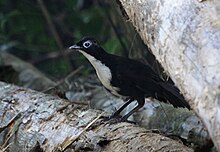
A songbird is a bird belonging to the suborder Passeri of the perching birds (Passeriformes). Another name that is sometimes seen as the scientific or vernacular name is Oscines, from Latin oscen, "songbird". The Passeriformes contains 5,000 or so species found all over the world, in which the vocal organ typically is developed in such a way as to produce a diverse and elaborate bird song.

There are seven species of Australasian treecreeper in the passerine bird family Climacteridae. They are medium-small, mostly brown birds with patterning on their underparts, and all are endemic to Australia-New Guinea. They resemble, but are not closely related to, the Holarctic treecreepers. The family is one of several families identified by DNA–DNA hybridisation studies to be part of the Australo-Papuan songbird radiation. There is some molecular support for suggesting that their closest relatives are the large lyrebirds.

Psophodidae is a family of passerine birds native to Australia and nearby areas. It has a complicated taxonomic history and different authors vary in which birds they include in the family. In the strictest sense, it includes only the five or six species of whipbirds and wedgebills, but some authors also include the quail-thrushes (Cinclosoma), eight species of ground-dwelling birds found in Australia and New Guinea, and the jewel-babblers (Ptilorrhoa), three or four species found in rainforest in New Guinea. Others place them in their own family, the Cinclosomatidae. The Malaysian rail-babbler was formerly sometimes placed in this family, which would then be called Eupetidae.

Cuculus saturatus, better well known as the Himalayan cuckoo or Oriental cuckoo, is a brooding parasitic bird that is part of the Cuculidae family. The species breeds from the Himalayas eastward to southern China and Taiwan. It migrates to southeast Asia and the Greater Sunda Islands for the winter.

The eastern whipbird is an insectivorous passerine bird native to the east coast of Australia. Its whip-crack song is a familiar sound in forests of eastern Australia. Two subspecies are recognised. Heard much more often than seen, it is dark olive-green and black in colour with a distinctive white cheek patch and a crest. The male and female are similar in plumage.

The buff-breasted paradise kingfisher is a bird in the tree kingfisher subfamily, Halcyoninae. It is native to Australia and New Guinea. It migrates in November from New Guinea to its breeding grounds in the rainforest of North Queensland, Australia. Like all paradise kingfishers, this bird has colourful plumage with a red bill, buff breast and distinctive long tail streamers.

The white-throated nightjar or white-throated eared-nightjar is a species of nightjar in the family Caprimulgidae. It is endemic to eastern Australia; it is a non-breeding winter visitor in Papua New Guinea. Its natural habitat is subtropical or tropical dry forests.

The orange-crowned fairywren is a species of passerine bird in the Australasian wren family, Maluridae. It is monotypic within the genus Clytomyias. It is found on New Guinea in its natural habitat of subtropical or tropical moist montane forests.

The fairy gerygone, previously known as the fairy warbler, is a species of bird in the family Acanthizidae native to New Guinea and Queensland.

The lemon-bellied flyrobin or lemon-bellied flycatcher is a species of bird in the family Petroicidae. Found in Australia, Indonesia, and Papua New Guinea, its natural habitats are subtropical or tropical moist lowland forests and subtropical or tropical mangrove forests.

The leaden flycatcher is a species of passerine bird in the family Monarchidae. Around 15 cm (6 in) in length, the male is lustrous azure with white underparts, while the female possesses leaden head, mantle and back and rufous throat and breast. It is found in eastern and northern Australia, Indonesia, and Papua New Guinea. Its natural habitat is subtropical or tropical mangrove forests in the northern parts of its range, in the south and inland it is eucalypt woodland.

The Papuan logrunner or New Guinea logrunner is a species of bird in the family Orthonychidae. It was formerly considered conspecific with the Australian logrunner.

The Australian logrunner is a species of bird that is endemic to eastern Australia where it uses unique foraging techniques and adaptations to search for its food on the floors of temperate, subtropical, or tropical moist lowland forests in south-eastern Australia. Until 2002, it was widely considered to be conspecific with the New Guinea logrunner, but studies showed the two differ significantly, both genetically and vocally.

The chowchilla is a passerine bird in the family Orthonychidae. It is endemic to Australia.
Orthonyx kaldowinyeri is an extinct species of logrunner from the Late Oligocene to the Miocene of Australia. It was described by Walter Boles from fossil material found at the Last Minute Site of Riversleigh, in the Boodjamulla National Park of north-western Queensland. It was a relatively small logrunner. The specific epithet kaldowinyeri is an Aboriginal term for “old”, referring to the Miocene age of the species which is earlier than that of other members of the genus.

Cinclosomatidae is a family of passerine birds native to Australia and New Guinea. It has a complicated taxonomic history and different authors vary in which birds they include in the family. It includes the quail-thrushes and jewel-babblers.


















